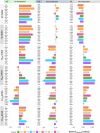Interrelating differences in structural and functional connectivity in the older adult's brain
- PMID: 35916531
- PMCID: PMC9704795
- DOI: 10.1002/hbm.26030
Interrelating differences in structural and functional connectivity in the older adult's brain
Abstract
In the normal aging process, the functional connectome restructures and shows a shift from more segregated to more integrated brain networks, which manifests itself in highly different cognitive performances in older adults. Underpinnings of this reorganization are not fully understood, but may be related to age-related differences in structural connectivity, the underlying scaffold for information exchange between regions. The structure-function relationship might be a promising factor to understand the neurobiological sources of interindividual cognitive variability, but remain unclear in older adults. Here, we used diffusion weighted and resting-state functional magnetic resonance imaging as well as cognitive performance data of 573 older subjects from the 1000BRAINS cohort (55-85 years, 287 males) and performed a partial least square regression on 400 regional functional and structural connectivity (FC and SC, respectively) estimates comprising seven resting-state networks. Our aim was to identify FC and SC patterns that are, together with cognitive performance, characteristic of the older adults aging process. Results revealed three different aging profiles prevalent in older adults. FC was found to behave differently depending on the severity of age-related SC deteriorations. A functionally highly interconnected system is associated with a structural connectome that shows only minor age-related decreases. Because this connectivity profile was associated with the most severe age-related cognitive decline, a more interconnected FC system in older adults points to a process of dedifferentiation. Thus, functional network integration appears to increase primarily when SC begins to decline, but this does not appear to mitigate the decline in cognitive performance.
Keywords: aging; cognitive performance; functional connectivity; multivariate analyses; structural connectivity.
© 2022 The Authors. Human Brain Mapping published by Wiley Periodicals LLC.
Conflict of interest statement
No competing interests were declared.
Figures




Similar articles
-
Heritability and interindividual variability of regional structure-function coupling.Nat Commun. 2021 Aug 12;12(1):4894. doi: 10.1038/s41467-021-25184-4. Nat Commun. 2021. PMID: 34385454 Free PMC article.
-
Functional and structural syntax networks in aging.Neuroimage. 2013 Dec;83:513-23. doi: 10.1016/j.neuroimage.2013.07.018. Epub 2013 Jul 16. Neuroimage. 2013. PMID: 23867559
-
Unique Mapping of Structural and Functional Connectivity on Cognition.J Neurosci. 2018 Nov 7;38(45):9658-9667. doi: 10.1523/JNEUROSCI.0900-18.2018. Epub 2018 Sep 24. J Neurosci. 2018. PMID: 30249801 Free PMC article.
-
Bilingual experience and intrinsic functional connectivity in adults, aging, and Alzheimer's disease.Ann N Y Acad Sci. 2021 Dec;1505(1):8-22. doi: 10.1111/nyas.14666. Epub 2021 Jul 26. Ann N Y Acad Sci. 2021. PMID: 34309857 Review.
-
Ageing, neuronal connectivity and brain disorders: an unsolved ripple effect.Mol Neurobiol. 2011 Apr;43(2):124-30. doi: 10.1007/s12035-011-8164-6. Epub 2011 Jan 15. Mol Neurobiol. 2011. PMID: 21234815 Review.
Cited by
-
Prediction of Verbal Abilities From Brain Connectivity Data Across the Lifespan Using a Machine Learning Approach.Hum Brain Mapp. 2025 Apr 1;46(5):e70191. doi: 10.1002/hbm.70191. Hum Brain Mapp. 2025. PMID: 40130301 Free PMC article.
-
A novel integration of brain structural and functional connectivity for identifying traumatic brain injury induced perturbations.J Neurosci Methods. 2025 Jul;419:110459. doi: 10.1016/j.jneumeth.2025.110459. Epub 2025 Apr 22. J Neurosci Methods. 2025. PMID: 40273994
-
Prediction of cognitive performance differences in older age from multimodal neuroimaging data.Geroscience. 2024 Feb;46(1):283-308. doi: 10.1007/s11357-023-00831-4. Epub 2023 Jun 13. Geroscience. 2024. PMID: 37308769 Free PMC article.
-
Age-related alterations in functional and structural networks in the brain in macaque monkeys.Front Neuroanat. 2025 Mar 25;19:1495735. doi: 10.3389/fnana.2025.1495735. eCollection 2025. Front Neuroanat. 2025. PMID: 40201576 Free PMC article.
-
Network-based statistics distinguish anomic and Broca's aphasia.Brain Struct Funct. 2024 Dec;229(9):2237-2253. doi: 10.1007/s00429-023-02738-4. Epub 2023 Dec 30. Brain Struct Funct. 2024. PMID: 38160205
References
Publication types
MeSH terms
LinkOut - more resources
Full Text Sources

